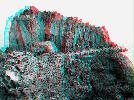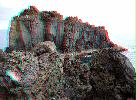Hi Chris,
I love the picturesque and textural quality of
your image. Good find!
The information below is not meant just for you as
you and others may already have knowledge of some of it.
Some friendly advice... (The 1.05 MB image exceeded
our group's suggested maximum 400 - 500K limit). The unnecessary
large file size takes up unneeded disk space on the group's archive as well as
being difficult for some members still using dial up access. Resizing the
resolution and file size (which are separate entities) and saving as JPEG (.jpg
extension) should not in most cases detrimentally affect image quality to the
naked eye.
Please don't flinch. :
) And please don't count your strikes, otherwise I would be
"out" a long time ago. : )
The following text and attached examples of
your image are my attempt to help you and other members
presently trying to understand the difference between a WV (object cutting the
edge of the Stereo Window) and TTW (Pop Out,) effect (not to be confused with a
Phantogram - "Pop up"). The TTW effect pushes and object (usually
Nearest Point Object) of an
image through the Stereo Window to make it seem closer to the viewer than
the Stereo Window. Correctly accomplished, the object being pushed in this
way should not touch any portion of the SW (Stereo
Window).
I changed your image file size to around
100K. The quality will not be as good as having the original stereo pair
but should suffice for the explanation suggested below. See if you can
tell the difference between the two examples and hopefully make sense of my
explanation. The examples
do not show dramatic or extreme
differences which means it may be more difficult to notice. This is why
Shahrokh's link explaining WV and Stereo Window should be most helpful
to beginning enthusiasts.
.. http://www.dabiri.8m.com/Stereo-Window/
The composition of this particular image doesn't really
allow for a TTW (Through The
Window) effect without introducing a WV
(Window violation). The WV causes eye strain as the brain may not
consciously notice what's wrong but struggles subconsciously to make sense of
what would in the real world be impossible. In other words, imagine that
you are actually viewing this scene through a real "physical"
window. If the rock formations actually came through our physical
window, it would penetrate (violate) the physical window frame! Our digital
solution is not go for a TTW or WV but simply push the image back behind the SW
(Stereo Window). The image looses a
little impact by being pushed back but overall it becomes much easier to
view. (See DSCF0320 Behind
SW.jpg "modified version of your image")
We have intentionally caused WV's in
the past but only for the sake of improving the overall view of an
image for the purpose of reducing ghosts. Now we can make use of the
"Floating Window" (FW) which is a different
topic but allows us to reduce the harshest ghosts without creating a typical
WV. I use the word typical because in actuality the FW is in itself a WV
but a friendly WV if used successfully. It is a tool... not a gimmick or
special effect and does not reduce ALL ghosts but improves the overall view and
appeal. (The newest version of SPM (Stero
Photo Maker) has access through the
menu for a Floating Window feature).
There will be other image opportunities that
lend themselves better for TTW without causing a WV. You will
eventually become aware of these opportunities while composing your image
before taking the shots. Other times, you may discover the
opportunity while in the image editing stage. The thing to look for is the
opportunity/ability to push the NPO (Nearest
Point Object) in the image through the window
(closer towards the viewer) without the object in the image touching
any portion of the Stereo Window's edge,
(as in reality).
Please don't take this the wrong way. Anyone
who's been reading ALL the posts in the group knows by now that I am all for
originality, creativity, experimentation, and thinking outside the box!
But even I through time, have come to know and acknowledge certain fundamental
rules that should be adhered to. (Later you may find
possible exceptions, as I believe there can be exceptions to
everything). I think it takes time to fully understand all of the
basic "rules" as it did for me and at least some trust, be it reserved,
from fellow seasoned members who have your best interest at heart. After
an understanding of these basics, then feel free to make your "choices" for your
own interests. I feel though that until that point is reached, we
should not lead new enthusiasts astray through misunderstanding of
basic principles.
Congratulations on a terrific shot Chris. We
should always keep original (high res) pairs and work from copies of them
so that if we wish, we can redo a stereo image.
Best regards,
Brian
----- Original Message -----
Sent: Friday, January 02, 2009 11:18
AM
Subject: [Anaglyphs] strike two
Volcanic rocks on the coast of
Madeira.
taken with two cheapo fujifilm A820's taped to a
cardboard box.
I'm flinching after the frame violation comments
from my last effort ! :-)
Chris
 (99K)
(99K) (101K)
(101K)